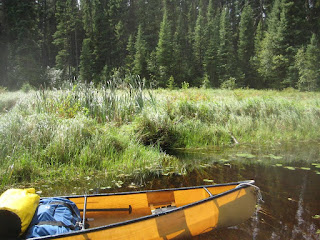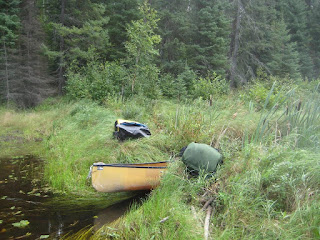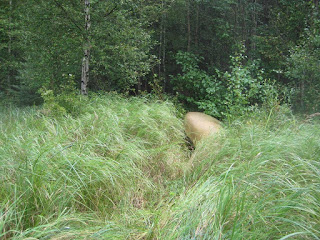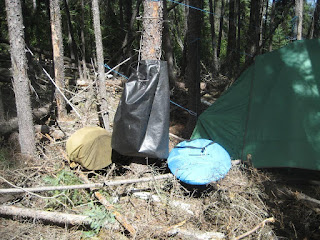The shoulder pads on the canoe carrying yoke are essential especially on long carries. The canoe "tump" canvas is very helpful, distributing some of the load to the top of my head. The canoe tump canvas is attributed to Cliff Jacobson, a well-published outdoor writer and wilderness canoeist.
Steven and I cleared this 250 metre portage before he left. It is a winter trapline trail.
A marten trap box laying on the ground until next trapping season.
I was able to paddle down the meandering "beaver creek" to the head of a boulder strewn overgrown rapids. Just before landing it started raining. I explored both sides of the creek to determine on which side I would portage.
After figuring out which side to portage, I unloaded the canoe and placed most of the gear under the overturned canoe to protect it from rain. I buried the cooler in moss as I knew I would be awhile before heading off again.
It took about two hours to cut a trail.
Before portaging, I built a fireplace and started a fire to shoo blackflies away when I stood in the smoke. Once I finished cutting the 150 metre trail, I ate lunch and dried out. The rain so far had been intermittent as storm clouds blew through so I managed to have lunch with only one rain shower. There was ready access to water from the creek. This would be a nice spot to camp.
The creek became more and more difficult to navigate due to its narrow and winding route through tall cattails. Strong wind blew in thunderstorms time after time. I stopped twice when the rain was torrential. As the creek wound through the valley, in some places it came close to one side or the other, and I managed to stop and shelter under the overhanging branches of a spruce tree. I reflected on the fact that I had left a beautiful campsite location to get me and my gear wet.
Beavers had once flooded much of the valley but now because of loss of food trees, they were long gone. If this 100 metre long dam had been still maintained, I would have had an easier trip. There was one narrow hole breached through the dam. I first stopped and removed as many loose branches and stones as I could, then tried sliding the canoe through. Fully loaded I could only manage to heave it about half way. Then I had to offload some of the gear until finally I could lift, pull, push the canoe all the way. It was a bit of a challenge reloading because the current was insistent on pulling the canoe downstream and there was nothing to anchor the canoe.
After much poling, paddling, wading, pushing, pulling, lifting, lining, towing I reached the next impenetrable rapids. After exploring both sides of the rapids to their end, I decided where I would portage, which needed a lot of cutting.
By this time I was quite rain-soaked, as were tree branches and undergrowth. I parked the canoe and placed much of the gear underneath to protect it from additional rain.
After three hours of cutting a trail, I portaged the gear and headed down the creek again. In short time I could see the target lake in the distance and thought I was home free.
However, the creek bed became shallower and narrower and the canoe became wedged in one spot in the very soft, very wet banks. There was no place to unload some of the gear. I was determined to get the canoe through without donning my wading gear. So I pushed, pulled, lifted, lined for 30 minutes and finally ... success. Aie! Still raining! Aie! But I say out loud to the rain gods "Well, better rain than forest fire."
Camp 30, after six km of travel, including three portages (250, 150 and 200 metres) and one km of "beaver creek" with six beaver dams. By evening the rain had stopped and I dried out near a warming fire. After a long hard day I was weary and hungry, the best recipe for tasty food.
The next two days were sunny and warm and I dried out all of my gear (the outer packs).
Usually I take the fishing rod apart and repack it. But I decided to leave it assembled and set under the canoe for safekeeping to try fishing again later. As soon as I set the canoe back down, I heard a snap. Aie! The top section of the fiberglass rod was broken. Aie! "Stupid is as stupid does." So, of course, duct tape to the rescue. But after the first cast, the rod bent like a limp ... so I removed the duct tape and cut off the top part. Thankfully the rod broke at the topmost section and was still functional.
A large orange caterpillar, the orange phase of the luna moth caterpillar when it is ready to spin a cocoon and pupate before emerging as a beautiful adult moth. The adult is active at night when I am long fast asleep.
Two old partial beaver skulls, probably caught and eaten by a bald eagle.

































































